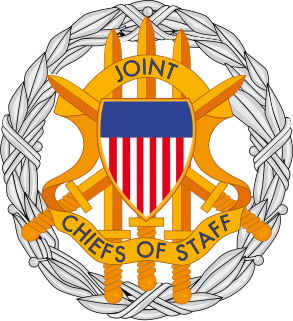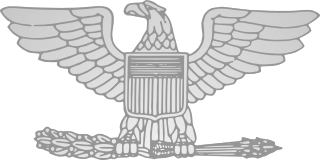
A military academy or service academy is an educational institution which prepares candidates for service in the officer corps. It normally provides education in a military environment, the exact definition depending on the country concerned.

The National War College (NWC) of the United States is a school in the National Defense University. It is housed in Roosevelt Hall on Fort Lesley J. McNair, Washington, D.C., the third-oldest Army post still active.
The United States Armed Forces are the military forces of the United States. The armed forces consists of six service branches: the Army, Marine Corps, Navy, Air Force, Space Force, and Coast Guard. The president of the United States is the commander-in-chief of the armed forces and forms military policy with the Department of Defense (DoD) and Department of Homeland Security (DHS), both federal executive departments, acting as the principal organs by which military policy is carried out. All six armed services are among the eight uniformed services of the United States.

The Joint Chiefs of Staff (JCS) is the body of the most senior uniformed leaders within the United States Department of Defense, that advises the president of the United States, the secretary of defense, the Homeland Security Council and the National Security Council on military matters. The composition of the Joint Chiefs of Staff is defined by statute and consists of a chairman (CJCS), a vice chairman (VJCS), the service chiefs of the Army, Marine Corps, Navy, Air Force, Space Force, and the chief of the National Guard Bureau. Each of the individual service chiefs, outside their JCS obligations, work directly under the secretaries of their respective military departments, e.g. the secretary of the Army, the secretary of the Navy, and the secretary of the Air Force.

The Naval War College is the staff college and "Home of Thought" for the United States Navy at Naval Station Newport in Newport, Rhode Island. The NWC educates and develops leaders, supports defining the future Navy and associated roles and missions, supports combat readiness, and strengthens global maritime partnerships.

The Goldwater–Nichols Department of Defense Reorganization Act of October 4, 1986Pub.L. 99–433,, made the most sweeping changes to the United States Department of Defense since the department was established in the National Security Act of 1947 by reworking the command structure of the U.S. military. It increased the powers of the chairman of the Joint Chiefs of Staff and implemented some of the suggestions from the Packard Commission, commissioned by President Reagan in 1985. Among other changes, Goldwater–Nichols streamlined the military chain of command, which now runs from the president through the secretary of defense directly to combatant commanders, bypassing the service chiefs. The service chiefs were assigned to an advisory role to the president and the secretary of defense, and given the responsibility for training and equipping personnel for the unified combatant commands.

The Norwegian Armed Forces is the military organisation responsible for the defence of Norway. It consists of five branches, the Norwegian Army, the Royal Norwegian Navy, which includes the Coast Guard, the Royal Norwegian Air Force, the Home Guard, and Norwegian Cyber Defence Force as well as several joint departments.

A unified combatant command (CCMD), also referred to as a combatant command, is a joint military command of the United States Department of Defense that is composed of units from two or more service branches of the United States Armed Forces, and conducts broad and continuing missions. There are currently 11 unified combatant commands and each are established as the highest echelons of military commands, in order to provide effective command and control of all U.S. military forces, regardless of branch of service, during peace or during war time. Unified combatant commands are organized either on a geographical basis or on a functional basis, e.g. special operations, force projection, transport, and cybersecurity. Currently, seven combatant commands are designated as geographical, and four are designated as functional. Unified combatant commands are "joint" commands and have specific badges denoting their affiliation.

In the United States Army, Marine Corps, Air Force and Space Force, colonel is the most senior field-grade military officer rank, immediately above the rank of lieutenant colonel and just below the rank of brigadier general. It is equivalent to the naval rank of captain in the other uniformed services. By law, an officer previously required at least 22 years of cumulative service and a minimum of three years as a lieutenant colonel before being promoted to colonel. With the signing of the National Defense Authorization Act of 2019, military services now have the authorization to directly commission new officers up to the rank of colonel. The pay grade for colonel is O-6.

The National Defense University (NDU) is an institution of higher education funded by the United States Department of Defense, intended to facilitate high-level education, training, and professional development of national security leaders. As a chairman's Controlled Activity, NDU operates under the guidance of the Chairman of the Joint Chiefs of Staff (CJCS), with Lieutenant General Michael T. Plehn, USAF, as president. It is located on the grounds of Fort Lesley J. McNair in Washington, D.C.

Fort Lesley J. McNair is a United States Army post located on the tip of Greenleaf Point, the peninsula that lies at the confluence of the Potomac River and the Anacostia River in Washington, D.C. To the peninsula's west is the Washington Channel, while the Anacostia River is on its south side. Originally named Washington Arsenal, the fort has been an army post for more than 200 years, third in length of service, after the United States Military Academy at West Point and the Carlisle Barracks. The fort is named for General Lesley James McNair, who was killed in action by friendly fire in Normandy, France during World War II.

Air University is a professional military education university system of the United States Air Force. It is accredited by the Commission on Colleges of the Southern Association of Colleges and Schools to award master's degrees.

The Joint Forces Staff College (JFSC), located in Norfolk, Virginia, was established as the Armed Forces Staff College in 1946 and incorporated into the National Defense University in August 1981. It educates and acculturates joint and multinational warfighters to plan and lead at the operational level. Military operations increasingly require the Armed Services to work jointly, and JFSC provides students the tools to operate in a joint environment. JFSC is composed of four schools, each with different student populations and purposes.

The Air War College (AWC) is the senior Professional Military Education (PME) school of the U.S. Air Force. A part of the United States Air Force's Air University, AWC emphasizes the employment of air, space, and cyberspace in joint operations. Headquartered at Maxwell Air Force Base in Montgomery, Alabama, its higher headquarters is the Air Education and Training Command (AETC) at Randolph Air Force Base in San Antonio, Texas. It is one of six war colleges within the U.S. Department of Defense's Joint Professional Military Education (JPME) Phase II Education Program for commissioned officers.

The Dwight D. Eisenhower School for National Security and Resource Strategy, formerly known as the Industrial College of the Armed Forces (ICAF), is a part of the National Defense University. It was renamed on September 6, 2012, in honor of Dwight D. Eisenhower who graduated from this school when it was previously known as the Army Industrial College.

The Air Command and Staff College (ACSC) is located at Maxwell Air Force Base in Montgomery, Alabama and is the United States Air Force's intermediate-level Professional Military Education (PME) school. It is a subordinate command of the Air University (AU), also located at Maxwell AFB, and is part of the Air Education and Training Command (AETC) headquartered at Randolph Air Force Base, Texas.
The Defence Services Command and Staff College (DSCSC) is situated at Batalanda, Makola (South) 12 Kilometers away from Colombo and its aim to develop the professional knowledge and understanding of experienced officers of the Sri Lanka Army, Sri Lanka Navy & the Sri Lanka Air Force to prepare them for the ranks of junior field officers in the army and the respective ranks of the Navy and Air force. The DSCSC was formerly known as the Sri Lanka Army Command and Staff College (ACSC).

Thomas Paul "Tom" Meek was a United States Navy officer for 31 years, retiring at the rank of two-star Rear Admiral.

The National Defence University (NDU), formerly introduced as Army War Course (1963–70), the National Defence College (1970–2007), is the military university with additional status of public university of the Islamic Republic of Pakistan focused on military education and training for the armed forces, including Pakistan military forces and two hundred foreign participants. Formerly established on 28 May 1970 at Rawalpindi, its academic principles are focused on command instructions, national security, military strategy, and war studies among other specified academic disciplines. It is one of the oldest military education and training institutes in the country with additional enrollments reserved for the civil servants.

The Marine Corps War College (MCWAR), is the senior school of the Marine Corps University, providing Joint Professional Military Education (JPME) to selected United States military officers, civilian Government officials, and international military officers. The college prepares officers for future senior command and staff responsibilities requiring exceptional operational competence, sound military judgment, and strategic thinking. The college is located within the Marine Corps University aboard Marine Corps Base Quantico, Virginia.


















